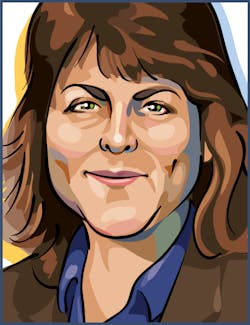
Laser Focus World chief editor Conard Holton opened the 2015 Lasers & Photonics Marketplace Seminar (http://www.marketplaceseminar.com) informing the 150 or so attendees that it was also the 50th anniversary of Laser Focus World—indeed something to celebrate in today's declining print world. In fact, our magazine still distributes print issues to about 50% of its readers, although we credit our longevity to the ability to play well in the digital environment (a much easier advertising sell considering that digital advertising is measurable and there are new and interesting ways to reach our 65,000 subscribers including webcasts and eNewsletters).
But enough of that; now for some highlights of our 2015 Seminar, held in conjunction with SPIE Photonics West on February 9, 2015 at the Marriott Marquis hotel.
An ultrafast keynote
The sessions began with a keynote on the ultrafast future from Ursula Keller in the Ultrafast Laser Physics Group at ETH Zurich and inventor of the passively mode-locked diode-pumped solid-state (DPSS) laser in 1992, made possible by a semiconductor saturable absorber mirror or SESAM. In fact, Keller says that the first commercial SESAM laser launched in 1996, just four years after the invention. Today, she says that these DPSS ultrafast lasers need higher powers and lower cost to meet a myriad of emerging applications.
On the horizon are power scaling technologies to the kilowatt, megahertz regime and the use of other saturable absorbers such as graphene. Unfortunately, graphene SESAMs or GSAMs are damaged by the laser before reaching saturation and are just not competitive yet with SESAM technology. And because Ti:sapphire lasers cannot reach kilowatt powers, she sees fiber chirped-pulse amplification (CPA) and INNOSLAB and thin-disk amplifiers meeting these needs along with the high-peak-power delivery enabled by kagome hollow-core photonic-crystal fiber for power scaling of gigahertz ultrafast systems.
Finally, vertical-external-cavity surface-emitting or VECSEL lasers or Novalux VECSELs called NECSELs are on the horizon. Another acronym to watch is the MIXSEL with 253 fs at 3.3 GHz rep rate.
By the numbers
Some of the "secret sauce" that makes the Seminar so appealing is Allen Nogee's presentation on the actual numbers that are forecast by Strategies Unlimited for the 2015 laser market. Growing from around $9.2 billion in 2014 to about $9.7 billion in 2015, Nogee cites materials processing weakness estimated for 2015, a continued rise in medical laser sales with the exception of slow penetration of lasers into dental markets, some estimated slowing in telecom, but a healthy oil and gas and 3D printing experience for laser manufacturers playing in those sectors.
In the semiconductor space, consumer electronics revenue from developing countries will overtake developed country markets. With 75% of the marking lasers coming from China, US and European laser makers continue to focus on higher-end devices for high-power materials processing and sensing/R&D markets. Quantum-cascade laser revenue continues to be small due to high-price models, but will improve for spectrometry and standoff detection applications as prices decrease and Internet of Things (IoT) applications continue to grow. Much more detail is provided in The Worldwide Market for Lasers: Market Review and Forecast 2015 report.
The fantastic voyage
Gary Tearney of the Wellman Center for Photomedicine took us inside the human body, much as the Fantastic Voyage film did in the 1960s. He related that imaging needs to take place both at the whole body level as well as at the cellular level, and that cellular processes affect tissue architectures. This imaging needs both confocal resolution in a small field as well as OCT resolution in a larger field to find both cellular and architectural changes indicative of disease. Incredibly, 1 cm images at 1 micron resolution are possible using OCT, confocal, and pill-cam or capsule imaging. Now, they just need to get better. He looks towards micro OCT for higher resolution and micro fluorescent microscopy to find hidden disease markers.
Be sure to see our other PHOTON FOCUS blog postings that review the remainder of the 2015 Lasers & Photonics Marketplace Seminar (http://www.marketplaceseminar.com) presentations.
About the Author

Gail Overton
Senior Editor (2004-2020)
Gail has more than 30 years of engineering, marketing, product management, and editorial experience in the photonics and optical communications industry. Before joining the staff at Laser Focus World in 2004, she held many product management and product marketing roles in the fiber-optics industry, most notably at Hughes (El Segundo, CA), GTE Labs (Waltham, MA), Corning (Corning, NY), Photon Kinetics (Beaverton, OR), and Newport Corporation (Irvine, CA). During her marketing career, Gail published articles in WDM Solutions and Sensors magazine and traveled internationally to conduct product and sales training. Gail received her BS degree in physics, with an emphasis in optics, from San Diego State University in San Diego, CA in May 1986.